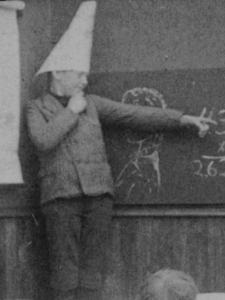Studies flunk class-size reduction
(Cross-posted from Union Watch.)
Oct. 17, 2012
By Larry Sand
It’s time to “just say no” to the small class-size pushers and eliminate seniority as a staffing mechanism.
Small class size means less work for teachers. Parents seem to think that their child will be better educated in a room with fewer classmates. Unions love fewer kids in a class because it equates to a larger workforce, which means more money and power for them. Only problem is that small class size does not lead to greater student achievement. It just means more hiring, then laying off the same teachers and punishing taxpayers who needlessly pay for a bloated workforce.
Last week, the Wall Street Journal published “The Imaginary Teacher Shortage,” an op-ed by professor of education reform at the University of Arkansas Jay Greene, in which he exposes the small-is-better canard:
“For decades we have tried to boost academic outcomes by hiring more teachers, and we have essentially nothing to show for it. In 1970, public schools employed 2.06 million teachers, or one for every 22.3 students, according to the U.S. Department of Education’s Digest of Education Statistics. In 2012, we have 3.27 million teachers, one for every 15.2 students.”
Greene also addresses the fact that, as hiring increases, there is less likelihood of a student getting a good teacher. And a having a good teacher is the most important factor in student achievement.
“Parents like the idea of smaller class sizes in the same way that people like the idea of having a personal chef. Parents imagine that their kids will have one of the Iron Chefs. But when you have to hire almost 3.3 million chefs, you’re liable to end up with something closer to the fry-guy from the local burger joint.”
Too many teachers
Just three months ago, director of Cato’s Center for Educational Freedom Andrew Coulson wrote a similar op-ed in the same newspaper. The subhead in “America Has Too Many Teachers” sets the tone:
“Public-school employees have doubled in 40 years while student enrollment has increased by only 8.5%—and academic results have stagnated.”
In the body of the piece, he gives us some numbers to chew on. Whereas Greene talks specifically about teachers, Coulson refers to the entire “public school workforce”:
“Since 1970, the public school workforce has roughly doubled—to 6.4 million from 3.3 million—and two-thirds of those new hires are teachers or teachers’ aides. Over the same period, enrollment rose by a tepid 8.5%. Employment has thus grown 11 times faster than enrollment. (Emphasis added.) If we returned to the student-to-staff ratio of 1970, American taxpayers would save about $210 billion annually in personnel costs.”
I contributed my own two cents on the subject in City Journal in July of 2011:
“In 1998, Hoover Institution senior fellow and economist Eric Hanushek released the results of his impressive review of class-size studies. Examining 277 separate studies on the effect of teacher-pupil ratios and class-size averages on student achievement, he found that 15 percent of the studies found an improvement in achievement, while 72 percent found no effect at all—and 13 percent found that reducing class size had a negative effect on achievement. While Hanushek admits that in some cases, children might benefit from a small-class environment, there is no way ‘to describe a priori situations where reduced class size will be beneficial.’”
So, basically, almost three-quarters of all the studies showed no benefit to small class size, and of the rest, almost the same number revealed negative effects as positive ones.
Layoffs
While it is a personal hardship for a teacher to be laid off, no one should be surprised when it happens. When economic times are good, it’s easy to buy into more hiring. But good economic times don’t last forever; and when, suddenly, we can’t afford all the teachers we have hired and some need to be let go, it is brazen of the self-righteous, small class-size true believers to mislead the public with their hand-wringing and political posturing.
And we can’t say we weren’t warned that there were going to be problems. Back in April of 2004, teacher union watchdog Mike Antonucci wrote:
“Enrollment Figures Spell Big Trouble for Education Labor.
“The U.S. Department of Education’s National Center for Education Statistics (NCES) regularly reviews enrollment figures, comparing past years with expectations for the future. Its most recent report shows clearly that the fat years of teacher employment are over, and the lean years may last much longer than anyone has previously predicted.
“NCES compared the period 1988-2001 with its projections for 2001-2013. The differences are stark. While public school enrollment increased 19 percent between 1988 and 2001, it is expected to grow only 4 percent between 2001 and 2013. During the period 1988-2001, the number of public school teachers grew by an astonishing 29 percent. The forecast for 2001-2013 is growth of only 5 percent–or less than 0.4 percent annually.”
Then in June 2004, referring to Rankings and Estimates, a National Education Association report, Antonucci wrote:
“In 2003-04, American public elementary schools taught 1,649,027 more pupils than they did in 1993-94. But there were 247,620 more elementary school classroom teachers in 2003-04 than there were in 1993-94. Simply put, for every 20 additional students enrolled in America’s K-8 schools in the last 10 years, we hired three additional elementary school classroom teachers.”
So clearly, having fewer teachers is not necessarily a bad thing, but it is tragic when we lose the good ones. Throughout much of the country, the decisions as to which teachers get laid off are determined by archaic seniority policies.
Teachers-of-the-year are laid off before their mediocre or incompetent counterparts simply because the latter may have been hired a few days before the former. This is no way to run an education system. The sooner we get away from the smaller-is-better myth and turn our attention to scrapping the industrial style “last in, first out” method, the better.
About the author: Larry Sand, a former classroom teacher, is the president of the non-profit California Teachers Empowerment Network – a non-partisan, non-political group dedicated to providing teachers with reliable and balanced information about professional affiliations and positions on educational issues.
Related Articles
Govt. Feeding Schoolkids ‘Soylent Pink’
John Seiler: Our colleague Dave Roberts today reported on how the California Legislature might ban food trucks within 1,500 feet
Half of Cal kids flunk
John Seiler: Maybe the reason voters keep electing turkeys to office in California is that the state’s schooling system turns
Rising pension costs threaten California school funding
In a shock critics had warned against, Golden State schools discovered that their nation’s largest pension system, CalPERS, was on





